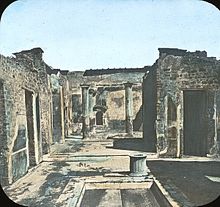


The House of the Tragic Poet (also called The Homeric House or The Iliadic House) is a Roman house in Pompeii, Italy dating to the 2nd century BCE. The house is famous for its elaborate mosaic floors and frescoes depicting scenes from Greek mythology.
Discovered in November 1824 by the archaeologist Antonio Bonucci, the House of the Tragic Poet has interested scholars and writers for generations. Although the size of the house itself is in no way remarkable, its interior decorations are not only numerous but of the highest quality among other frescoes and mosaics from ancient Pompeii. Because of the mismatch between the size of the house and the quality of its decoration, much has been wondered about the lives of the homeowners. Little is known about the family members, who were likely killed by the eruption of Mount Vesuvius in 79 AD.
Traditionally, Pompeii is geographically broken up into nine regional areas, which are then further broken up into insular areas. The House of the Tragic Poet sat in Regio VI, Insula 8, the far-western part of Pompeii. The house faced the Via di Nola, one of Pompeii's largest streets that linked the forum and the Street of the Tombs. Across the Via di Nola from the House of the Tragic Poet sat the Forum Baths of Pompeii.